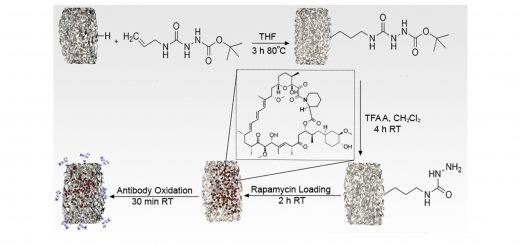New paper in Biomaterials

(Top) Cell morphology of NIH3T3 cultured on TCPS, THC silicon and PITHC pSi rugate filter surface at 24 h post-seeding. Actin filament in red, cell nuclei in blue. (Bottom) EdU incorporation assay. Green: EdU labelled nuclei of cells in S phase. Blue: all nuclei.
Tong and colleagues have recently published in Biomaterials their study on subcutaneous optical biosensors based on thermally hydrocarbonised porous silicon.
Advanced biosensors in future medicine hinge on the evolvement of biomaterials. Porous silicon (pSi), a generally biodegradable and biocompatible material that can be fabricated to include environment-responsive optical characteristics, is an excellent candidate for in vivo biosensors. However, the feasibility of using this material as a subcutaneously implanted optical biosensor has never been demonstrated. In there, they investigated the stability and biocompatibility of a thermally-hydrocarbonised (THC) pSi optical rugate filter, and demonstrated its optical functionality in vitro and in vivo. They first compared pSi films with different surface chemistries and observed that the material was cytotoxic despite the outstanding stability of the THC pSi films. They then showed that the cytotoxicity correlates with reactive oxygen species levels, which could be mitigated by pre-incubation of THC pSi (PITHC pSi). PITHC pSi facilitates normal cellular phenotypes and is biocompatible in vivo. Importantly, the material also possesses optical properties capable of responding to microenvironmental changes that are readable non-invasively in cell culture and subcutaneous settings. Collectively, they demonstrate, for the first time, that PITHC pSi rugate filters are both biocompatible and optically functional for lab-on-a-chip and subcutaneous biosensing scenarios. They believe that this study will deepen our understanding of cell–pSi interactions and foster the development of implantable biosensors.
You can find out more in: Biomaterials, 74 (2016) 217-230





